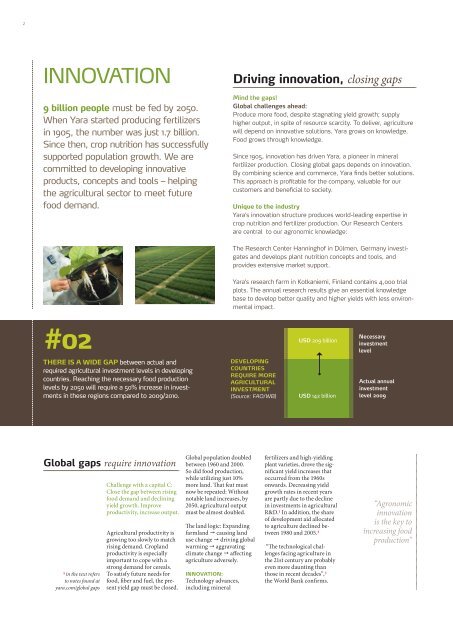Yara crop nutrition
Yara crop nutrition
Yara crop nutrition
Create successful ePaper yourself
Turn your PDF publications into a flip-book with our unique Google optimized e-Paper software.
2<br />
INNOVATION<br />
9 billion people must be fed by 2050.<br />
When <strong>Yara</strong> started producing fertilizers<br />
in 1905, the number was just 1.7 billion.<br />
Since then, <strong>crop</strong> <strong>nutrition</strong> has successfully<br />
supported population growth. We are<br />
committed to developing innovative<br />
products, concepts and tools – helping<br />
the agricul tural sector to meet future<br />
food demand.<br />
Driving innovation, closing gaps<br />
Mind the gaps!<br />
Global challenges ahead:<br />
Produce more food, despite stagnating yield growth; supply<br />
higher output, in spite of resource scarcity. To deliver, agriculture<br />
will depend on innovative solutions. <strong>Yara</strong> grows on knowledge.<br />
Food grows through knowledge.<br />
Since 1905, innovation has driven <strong>Yara</strong>, a pioneer in mineral<br />
fertilizer production. Closing global gaps depends on innovation.<br />
By combining science and commerce, <strong>Yara</strong> finds better solutions.<br />
This approach is profitable for the company, valuable for our<br />
customers and beneficial to society.<br />
Unique to the industry<br />
<strong>Yara</strong>’s innovation structure produces world-leading expertise in<br />
<strong>crop</strong> <strong>nutrition</strong> and fertilizer production. Our Research Centers<br />
are central to our agronomic knowledge:<br />
The Research Center Hanninghof in Dülmen, Germany investigates<br />
and develops plant <strong>nutrition</strong> con cepts and tools, and<br />
provides extensive market support.<br />
<strong>Yara</strong>'s research farm in Kotkaniemi, Finland contains 4,000 trial<br />
plots. The annual research results give an essential knowledge<br />
base to develop better quality and higher yields with less environmental<br />
impact.<br />
#02<br />
USD 209 billion<br />
Necessary<br />
investment<br />
level<br />
THERE IS A WIDE GAP between actual and<br />
required agricultural investment levels in developing<br />
countries. Reaching the necessary food production<br />
levels by 2050 will require a 50% increase in investments<br />
in these regions compared to 2009/2010.<br />
DEVELOPING<br />
COUNTRIES<br />
REQUIRE MORE<br />
AGRICULTURAL<br />
INVESTMENT<br />
(Source: FAO/WB)<br />
USD 142 billion<br />
Actual annual<br />
investment<br />
level 2009<br />
Global gaps require innovation<br />
x in the text refers<br />
to notes found at<br />
yara.com/global gaps<br />
Challenge with a capital C:<br />
Close the gap between rising<br />
food demand and declining<br />
yield growth. Improve<br />
productivity, increase output.<br />
Agricultural productivity is<br />
grow ing too slowly to match<br />
rising demand. Cropland<br />
productivity is especially<br />
important to cope with a<br />
strong demand for cereals.<br />
To satisfy future needs for<br />
food, fiber and fuel, the present<br />
yield gap must be closed.<br />
Global population doubled<br />
between 1960 and 2000.<br />
So did food production,<br />
while utilizing just 10%<br />
more land. That feat must<br />
now be repeated: Without<br />
notable land increases, by<br />
2050, agricultural output<br />
must be almost doubled.<br />
The land logic: Expanding<br />
farmland " causing land<br />
use change " driving global<br />
warming " aggravating<br />
climate change " affecting<br />
agriculture adversely.<br />
INNOVATION:<br />
Technology advances,<br />
including mineral<br />
fertilizers and high-yielding<br />
plant varieties, drove the significant<br />
yield increases that<br />
occurred from the 1960s<br />
on wards. Decreasing yield<br />
growth rates in recent years<br />
are partly due to the decline<br />
in investments in agricultural<br />
R&D. 1 In addition, the share<br />
of development aid allocated<br />
to agriculture declined between<br />
1980 and 2005. 2<br />
“The technological challenges<br />
facing agriculture in<br />
the 21st century are probably<br />
even more daunting than<br />
those in recent decades”, 3<br />
the World Bank confirms.<br />
“Agronomic<br />
innovation<br />
is the key to<br />
increasing food<br />
production”



